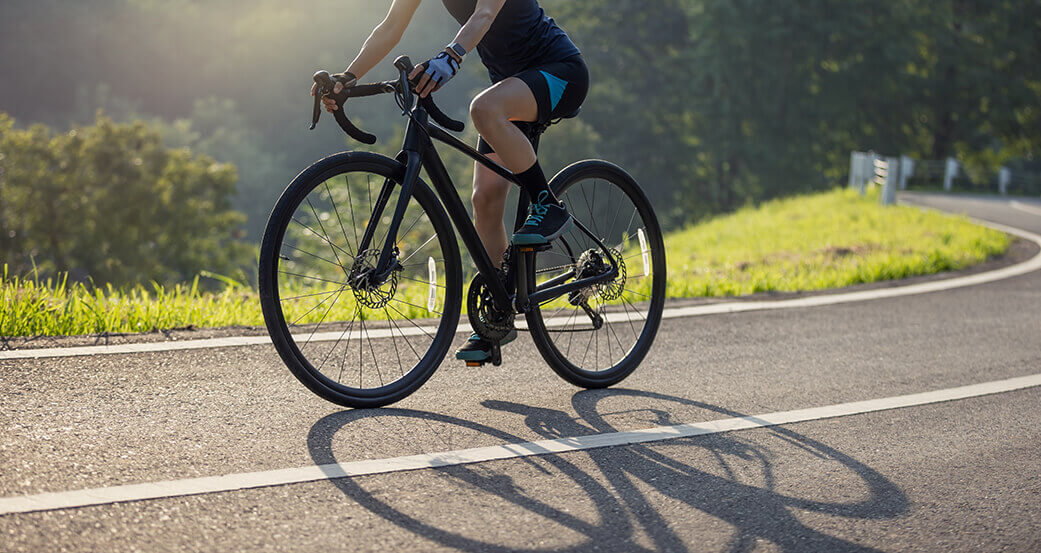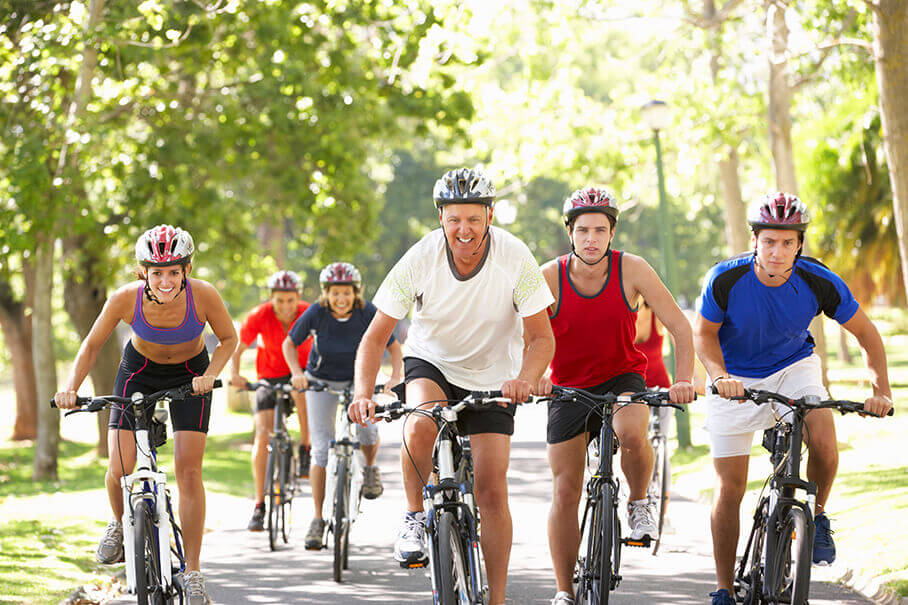Can cycling help you achieve your weight loss goals? Certainly. As a low-impact, high-reward exercise, weight loss with cycling is both feasible and sustainable. This article cuts through the noise to provide you with evidence-based strategies for using cycling as your go-to weight-loss workout. You’ll learn about caloric deficits, ride intensity, and how to tweak your cycling habits for maximum fat burn.
Key Takeaways
- Cycling is an effective and enjoyable weight loss activity that increases metabolic rate, burns calories and builds muscle, even aiding those with joint stress by providing low-impact exercise.
- To optimize weight loss, combine high-intensity interval training (HIIT) and long endurance rides, while ensuring a consistent caloric deficit through careful dietary management and cross-training exercises.
- Successful cycling-driven weight loss also relies on a balanced diet rich in proteins, healthy fats, and carbohydrates for fuel, with emphasized importance on tracking performance metrics and body composition, not just weight.
The Wheels of Weight Loss: How Cycling Burns Calories

Cycling is not only an effective weight loss strategy but also a fun way to achieve your fitness goals. Cycling offers several benefits for weight loss, including:
- Increased activity levels
- Calorie burning
- Improved heart health
- Enhanced fitness
- Muscle building, which helps burn calories even during rest
By incorporating cycling for weight loss into your routine, you can tick all the boxes for successful weight loss.
For individuals with joint concerns, cycling serves as an ideal exercise, as it reduces joint stress while effectively burning calories and aiding in weight loss. Plus, did you know that commuting by bike can have a remarkable impact on weight loss? Studies show that people who cycle for just 30 minutes each way to work can lose an average of 7kg over a year. This can also improve your power to weight ratio, which is crucial for enhancing your cycling performance.
The Calorie-Burning Engine: Your Metabolism on Two Wheels
Yet, how does cycling aid in weight loss? The answer lies within your metabolism. When you cycle, you maintain a sustained caloric deficit, which enhances your body’s metabolic rate and helps you lose fat. This is the cornerstone of weight loss, and cycling can help you achieve it in a fun and enjoyable way.
Comprehending and sustaining a caloric deficit is paramount to achieving weight loss success through cycling. This simply means that you’re burning more calories than you consume, setting the stage for your body to burn stored fat for energy and ultimately leading to weight loss.
Pacing the Burn: Understanding Intensity Levels in Cycling
For maximum weight loss results with cycling, you need to grasp the various cycling intensity levels and their contribution to calorie burning and fitness enhancement. Steady-state rides and high-intensity intervals are two key intensity levels that can be incorporated into your cycling routine to help you burn more calories and lose more weight.
High-Intensity Interval Training (HIIT) serves as a powerful approach to boosting fat burning. This type of training involves short, intense bursts of activity followed by short recovery periods. Scientifically proven to boost fat burn, HIIT can contribute to significant weight loss and help you burn fat effectively. In fact, high-intensity workouts increase post-exercise oxygen consumption, keeping your metabolism revved up for 24-36 hours after your workout. For best results, aim for three to four interval days a week, adjusting based on your own tolerance and progress.
Long Ride Benefits: Endurance Training and Fat Loss
Endurance-focused long rides offer another splendid method for fat burning and overall cardiovascular health improvement. Low Intensity, Steady State (LISS), or endurance cycling, is the key to shedding fat, especially when you commit to regular, lengthy rides. When you push your limits during these long endurance cycles, your body becomes a fat-burning machine. When you are on a long ride, be sure to use a wireless charging phone case and mount, so you can keep your phone fully charged and within view. Some benefits of endurance cycling include:
- Increased stamina and endurance
- Improved cardiovascular health
- Enhanced fat burning
- Reduced risk of chronic diseases
- Stress relief
So hop on your bike and start enjoying the benefits of endurance cycling today!
Endurance cycling provides additional benefits too. It:
- Engages more muscle groups
- Enhances calorie burn
- Strengthens your overall cardiovascular fitness
- Elevates your cardiorespiratory fitness
- Reduces the risk of cancer and its mortality rates
So, whether you spread your sessions over several days or complete them in a single day, it’s the cumulative hours that count towards achieving weight loss.
Crafting a Weight Loss Plan with Cycling at Its Core

Now that we have a grasp on how cycling aids in weight loss, we can proceed to formulate a cycling-centric weight loss plan. This involves setting realistic goals, managing calorie intake, and incorporating cross-training exercises.
For successful weight loss within a cycling-focused plan, here are some key tips:
- Create a calorie deficit by managing intake versus expenditure.
- Combine this with a healthy diet for the best results.
- Remember, sustained fat loss requires a consistent caloric deficit over time.
In addition to cycling, consider incorporating a variety of cross-training exercises such as:
- running
- hiking
- yoga
- cross-country skiing
- swimming
- pilates
This not only enhances overall fitness but also improves body composition, making your weight loss journey more effective. If you use your phone to track your journey, you should think about adding a wireless charging phone case to your arsenal so you will never be left with a dead phone.
Setting Realistic Goals: Defining Your Target Weight and Timeline
The first step towards successful weight loss is setting realistic and attainable goals. Before setting a weight-loss target, ensure it aligns with your riding characteristics and is achievable. Aiming for a target body fat percentage can provide a more precise measure of a healthy weight.
It’s also important to strive for a steady, moderate rate of weight loss, as losing excess weight at a rate of more than 3.5 kilos per month is likely unsustainable. To track your progress more accurately and improve your weight management, consider investing in weighing scales that measure body fat percentage, allowing you to see changes in body composition rather than just weight.
Balancing the Scales: Calorie Intake vs. Expenditure
The key to losing weight is achieving a calorie deficit. This simply means that you consume fewer calories than your body burns for energy, leading to weight loss. You can calculate your daily calorie intake for weight loss using a calorie calculator that takes into account your:
- age
- weight
- height
- level of physical activity
Cycling is a great way to boost your calorie burn. Here are some tips to maximize your caloric deficit:
- A moderate 30-minute stationary bike workout can burn approximately 260 calories
- A vigorous 30-minute session can burn around 378 calories
- Consider keeping a food journal to keep track of serving sizes and calorie counts
- Schedule workouts to align with regular meal times
Cross-Training: Complementing Cycling with Other Exercises
To optimize your weight loss journey as a cyclist, consider incorporating a range of cross-training exercises into your regimen. Some exercises to consider are:
- Running
- Hiking
- Yoga
- Cross-country skiing
- Swimming
- Pilates
These exercises can complement your cycling routine, enhancing overall fitness and body composition.
Yoga, for instance, is the perfect complement to cycling, helping you improve flexibility, build strength, and develop breathing techniques. Cross-training tackles performance limiters, shields against injury by adding variety to your workouts, and keeps you in top shape even during recovery, lowering the chance of overtraining and overuse injuries.
To achieve optimal weight loss, it’s recommended to incorporate a mix of three cycling workouts per week along with at least three indoor cycling sessions lasting at least thirty minutes each.
Nourishment on Two Wheels: Eating for Cycling and Weight Loss

What you eat is just as crucial to your weight loss journey as cycling is. It’s important to fuel your body with the right nutrients before, during, and after cycling to ensure optimal performance and aid in recovery. A balanced diet that supports cycling performance and weight loss includes proper meal timing, high-protein foods, and healthy fats and carbs.
Before and after a cycling ride, aim for a combination of low-GI carbohydrates, protein, and healthy fats. Here are some great options for pre-cycling meals, ideally consumed 3-4 hours before your ride:
- Oats
- Fruit
- Peanut butter
- Avocado
- Coconut oil
- Yogurt
- Eggs
- Fish
- Nuts
Additionally, a cup of coffee or espresso can provide a beneficial boost.
To keep your energy levels up during your long bike ride, make sure to fuel up with a mix of carbohydrates and protein. Consider options like:
- sandwiches
- rice bars
- energy bars
- dried fruit
- flapjacks
- energy gels
- fruit
- sport nutrition bars like CLIF BAR® energy bars.
Fueling the Ride: What to Eat Before, During, and After Cycling
Protein plays a key role in muscle recovery post-cycling. It stimulates muscle protein synthesis, reduces protein breakdown, and promotes muscle repair and building. So, after a cycling session, ensure you’re consuming a mix of protein and carbohydrates, which are essential for refueling and recovery. Aim to include about a quarter of your plate with high-protein foods such as:
- meat
- poultry
- fish
- eggs
- dairy
- tofu
- beans
Try to have around 3 ounces of lean proteins at each meal to fuel your body for cycling and support your weight loss journey.
Lean Muscle Mass Cuisine: High-Protein Foods for Recovery
While protein is vital for muscle recovery, carbohydrates and healthy fats are indispensable for fuelling your cycling. Some great sources of carbohydrates that can help keep your energy levels up during rides include:
- Quinoa
- Sports drinks
- Energy bars
- Small sandwiches
- Dried fruit
- Energy chews
- Flapjacks
Healthy fats, on the other hand, provide essential nutrients, such as omega-3 fatty acids and vitamins, that support energy production and overall health. Foods like salmon, avocados, and whole grains are packed with healthy fats that can fuel your cycling performance and enhance your overall well-being.
Healthy Fats and Carbs: Energy Sources That Support Weight Loss
Maintaining a healthy diet for weight loss is just as important as fuelling your body with the right nutrients for cycling. By focusing on fueling your body with nutrient-dense, unprocessed foods, you can maximize satiety while minimizing calorie intake. Here are some tips for a healthy diet:
- Opt for a variety of fruits and vegetables
- Steer clear of empty calories like alcohol and junk food
- Stay mindful of your body’s signals to avoid overeating
Remember, weight loss is not just about cutting calories but also about improving your diet quality and eating habits. So, as you pedal your way to fitness, make sure you’re also fueling your body with the right nutrients to support your weight loss journey and enhance your overall health, helping you to lose weight effectively.
Measuring Success Beyond the Scale
Remember, success extends beyond the scale, even though weight loss is a significant part of your journey. By tracking key cycling metrics, analyzing body composition, and recognizing non-metric achievements, you can gain a more comprehensive understanding of your progress and stay motivated.
Cycling metrics, including:
- Speed
- Average speed
- Distance
- Time
- Heart rate
- FTP (Functional Threshold Power)
- Calories
- Elevation
- Power
provide valuable insights into your performance improvements over time. Power meters, for instance, measure the work you’re doing and express it in watts, providing you with the data you need to make real improvements.
Be sure to use a bike phone mount and wireless charger when you are cycling, so you can keep track of your ride data without the worry about your phone battery dying. The StrideCharge Charge Case and Handlebar Mount is a great option to keep your phone securely mounted to your handlebars while you wireless charge it.
Key Cycling Metrics: Tracking Performance Gains
Heart rate tracking allows you to:
- Monitor training sessions
- Analyze fitness improvements
- Pace efforts
- Provide valuable data for monitoring and optimizing training intensity and effectiveness.
Body Composition Analysis: Seeing the Bigger Picture
Beyond cycling metrics, an analysis of body composition changes can offer a more holistic understanding of your weight loss progress. Body composition analysis in the context of weight loss is a powerful tool for evaluating the balance between fat mass and lean mass in your body. This is crucial because successful weight loss should prioritize reducing fat mass while maintaining lean mass for a healthy and sustainable transformation. Monitoring your body weight alongside body composition can provide a more comprehensive view of your progress.
Cycling is a fantastic way to improve your body composition by burning fat and building muscle.
Celebrating Milestones: Recognizing Non-Metric Achievements
Besides tracking progress, it’s also vital to celebrate milestones and acknowledge non-metric accomplishments. These include completing a challenging ride, improving cycling skills, or even embarking on cycling adventures across diverse landscapes.
Recognizing and celebrating these achievements, no matter how small, can boost morale, encourage consistency, and foster a sense of achievement.
Summary
To sum up, cycling is a powerful tool for weight loss, offering a fun, low-impact way to burn calories and improve overall fitness. By setting realistic goals, managing calorie intake, incorporating cross-training exercises, and fueling your body with the right nutrients, you can supercharge your weight loss journey with cycling. Remember, success is not just about the numbers on the scale but also about enjoyable rides, improved fitness, and a healthier lifestyle. So, gear up, hit the road, and pedal your way to a healthier you!
Frequently Asked Questions
Can I lose belly fat by cycling?
Yes, cycling can help you lose belly fat over time. Research has shown that combining cycling with weight training can prevent age-related belly fat gain and reduce existing belly fat. It may take time, but regular cycling can contribute to overall fat loss and a healthier weight.
Can I lose weight by cycling 30 minutes a day?
Yes, cycling for 30 minutes a day, three to four times a week can help you lose weight and improve your fitness levels significantly. It can burn about 1.3 kg of fat per month.
How much should I cycle a day to lose weight?
To lose substantial weight through cycling, aim for a moderate pace of 12-14 miles per day or about 84-98 miles per week. Remember to listen to your body, especially if you're just starting out.
Is cycling 1 hour a day enough to lose weight?
Yes, cycling 1 hour a day can help you lose weight, as it can burn between 420 and 588 calories, depending on your weight and intensity, and contribute to a calorie deficit, which is essential for weight loss.
How does cycling contribute to weight loss?
Cycling contributes to weight loss by boosting metabolism, burning calories, and improving overall fitness. Combining cycling with a healthy diet and consistent exercise routines can significantly enhance weight loss. So, get on your bike and start pedaling towards your weight loss goal!




Leave a comment
This site is protected by hCaptcha and the hCaptcha Privacy Policy and Terms of Service apply.